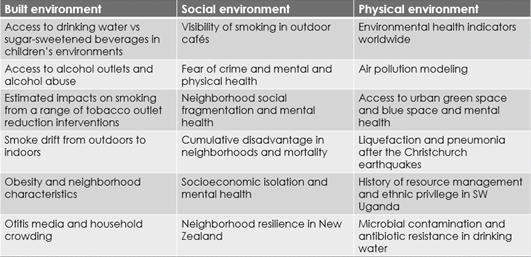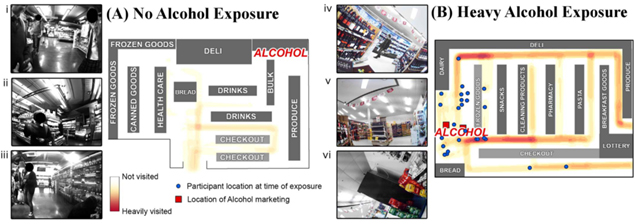Theme 2: Neighborhoods and Health - How Can The Built, Physical and Social Environment Promote Health?
Dr. Pearson’s research contributes to our understanding of the relationships between where we live, play, work, and study to our health.
Within this theme, her work involves aspects of the built, physical and social environments. She pays particular attention to inequalities in neighborhood
exposures and how these (potentially amenable) features may play a role in health inequalities. Given the gross health disparities between the rich, poor,
and various ethnic groups, Dr. Pearson has explored possible routes to lessening inequalities.
For example, she has examined features of the built environment that may promote healthy behaviors including fruit/vegetable consumption and physical activity and health outcomes such as obesity and mental health. She also examined how neighborhood features may actually hinder unhealthy behaviors such as smoking and harmful alcohol consumption. See the table below for examples of research Dr. Pearson has conducted in each domain.

Children's neighborhood environments
Kids’ Cam aimed to explore children’s everyday environments by documenting what children see and where they go throughout the day - while at home, at school and during most other activities. To directly and objectively capture the environment in which children live, children were asked to wear a GPS device, and a camera that hangs around the neck that automatically took still photographs every ~ 7 seconds. Each participant, in Wellington, New Zealand, wore the devices for four days. This project was one of the first in the world to use these cutting-edge technologies to explore children’s environments. The methodologies employed in this study can be found here.
The main purpose was to evaluate children’s exposure to unhealthy food (called ‘non-core’) marketing and examine possible inequalities. They found that, on average, children were exposed to non-core food marketing 27.3 times a day, or more than twice the average exposure to core food marketing. Most exposures occurred at home (33%), in public spaces (30%) and at school (19%). The study provides further evidence of the need for urgent action to reduce children’s exposure to marketing of unhealthy foods, and suggests the settings and media in which to act. Such action is necessary if the Commission on Ending Childhood Obesity’s vision is to be achieved. Watch a short video about this study here.
Dr. Pearson also led and supervised a number of projects within the Kids’Cam study. For example, she explored when, where and who sees blue spaces and participates in blue recreation. She also supervised studies related to how to define the extent of children’s neighborhoods and children’s exposure to alcohol marketing, with Tim Chambers. They found that in supermarkets where alcohol was sold, children encountered alcohol marketing on 85% of their visits. Alcohol marketing was frequently near everyday goods (bread and milk) or entrance/exit.

Socioeconomic and ethnic health inequalities - what aspects of neighborhoods could reduce inequalities?

Dr. Pearson aims to understand relationships between neighborhood environments and health inequalities. She pays particular attention to inequalities in neighborhood exposures and how these (potentially amenable either through zoning policy or changes to the built environment) features may play a role in health inequalities. She has examined features of the neighborhood that may promote health (e.g., resilient neighborhoods), or hinder health (e.g., tobacco retailers or obesogenic environments).
Evidence also suggests that health and economic inequalities in many countries are increasing in some areas but may be on the decline in others. While area-level deprivation at a single point in time is known to influence health, the literature relating to longitudinal deprivation of communities and associated health impacts is sparse. Dr. Pearson and colleagues evaluated to effect of historical trajectories of neighborhood deprivation on both current all-cause mortality and CVD-related mortality. They found that current deprivation was a slightly better predictor of mortality. This is encouraging, in that communities may reap health benefits when neighborhood conditions improve rather than suffering poor health due to historical disadvantage when current conditions are favorable. Still, understanding historical deprivation processes may yield useful insights into current conditions.